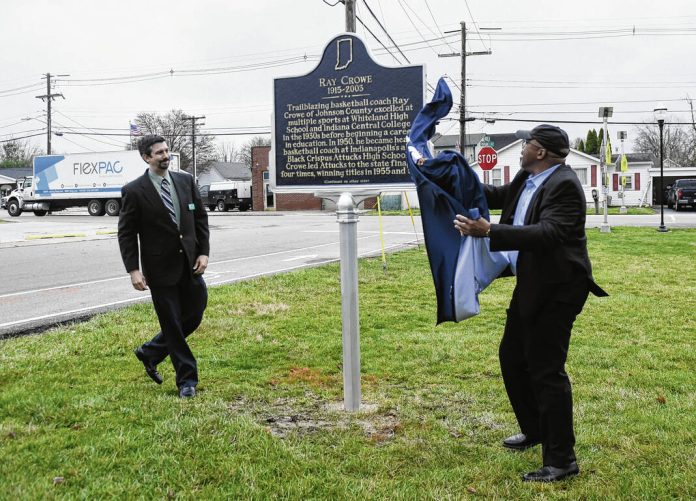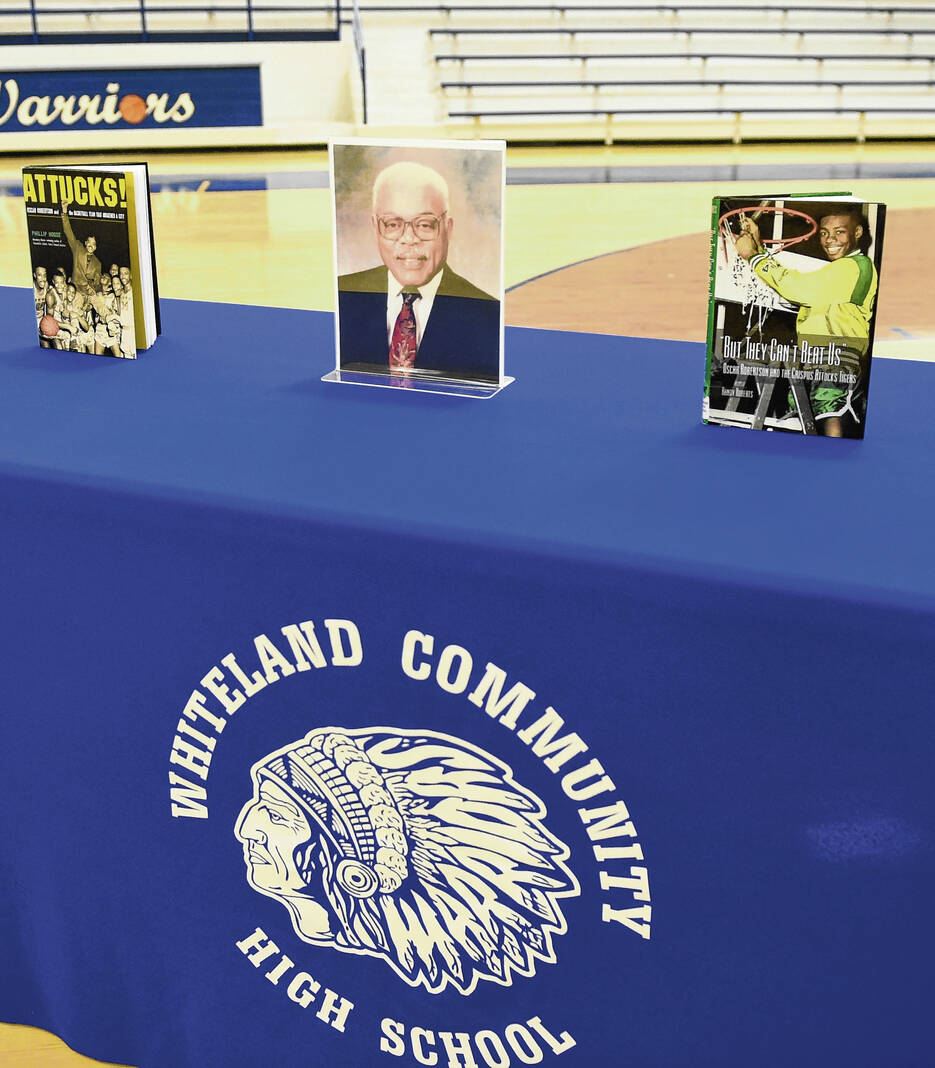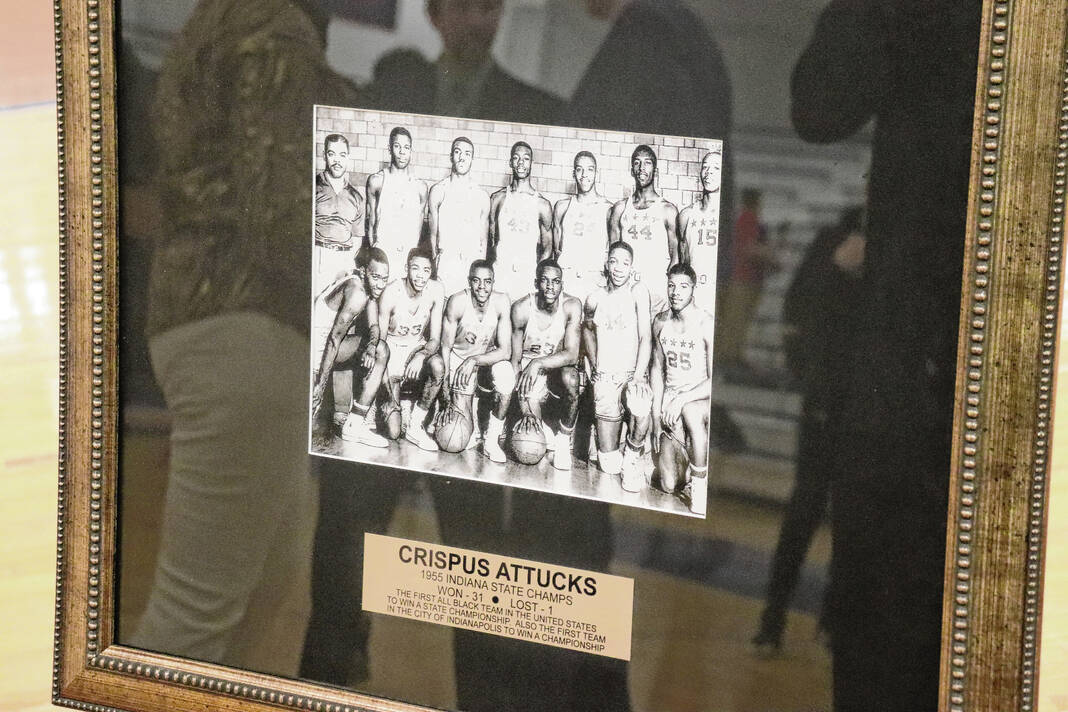
Larry Crowe unveils the new state historical marker honoring Ray Crowe, his father, outside the Clark-Pleasant School Corp. administration building in Whiteland on Friday. RYAN TRARES | DAILY JOURNAL
Ray Crowe’s historical impact still reverberates.
After excelling in multiple sports at Whiteland High School and Indiana Central College, he focused his attention on educating others. When he became the head basketball coach at Crispus Attucks High School, an all-Black school in Indianapolis, he led them to the state finals four times, winning in two titles.
He later led the Crispus Attucks athletics department, before serving in the Indiana House of Representatives.
Crowe’s accomplishments are many. But it was his values and integrity that truly set him apart.
“(Crowe) made a permanent mark with his character he persuaded, possessed and displayed to God, his family and his community,” said Robert Hays of the Crispus Attucks alumni group. “He served all three of these entities with his life, given to him by God, for 88 years.”
On Friday morning, Crowe’s significance and life was lauded once again. The community gathered with the Indiana Historical Bureau to dedicate a new state historical marker in Whiteland. More than 30 people stood on a chilly, gray morning at the corner of Main and Center streets to unveil the marker, before moving to the Whiteland Community High School gymnasium for a more formal reception.
Members of the Whiteland school community, students, Crispus Attucks alumni and Crowe’s own family — including some of his children and grandchildren — gathered together to pay homage to a man who left such a mark on both Whiteland and Indiana.
“We’re here to honor someone who basically did everything right. He stood for the right things,” said Butch Zike, former Whiteland athletics director and current Clark-Pleasant school board member.
Etched into the marker are the highlights of a life spent pushing for excellence. The placard lists his own athletic achievements before spotlighting his work at Crispus Attucks.
“Crowe’s emphasis on good sportsmanship and fast-paced, aggressive play helped Attucks become the first all-Black team to win the state championship and challenge pervasive racism,” the marker reads.
His Crispus Attucks teams were legendary. The Indiana High School Athletic Association had prohibited all-Black and Catholic schools from participating in the state basketball tournament until 1942. Even after that, all-Black schools found little success.
That changed in the 1950s, when Crispus Attucks went to four state finals, winning the titles in 1955 and 1956. They became the first all-Black team to win the state championship.
Oscar Robertson, a star on those championship teams and one of Indiana basketball’s greatest players, has said the success of Crowe’s Attucks teams helped racial relations in Indianapolis and eased integration of the public schools.
After moving on from coaching, Crowe served as athletic director at Crispus Attucks for 11 years before serving in the state House of Representatives from 1957 to 1967. He later was named director of Indy Parks and Recreation, and was elected as an Indianapolis City-County Council member.
“For those with his history, we hope it serves as an introductory point, and really a way to learn more about his influence,” said Casey Pfeiffer, marker manager for the Indiana Historical Bureau. “And for those who do know his story … it’s a reminder of his impact on Indiana basketball and education in the state.”
The historical marker was spearheaded by the Johnson County Museum of History and the Johnson County Historical Society.
“Our mission at the museum is to collect, preserve, interpret and promote the history of Johnson County, and honoring Ray Crowe definitely falls into that category,” said David Pfeiffer, director of the Johnson County Museum of History.
They needed to fill out an intensive application and demonstrate Crowe’s importance to the Indiana Historical Bureau. To be considered for a marker, applicants have to demonstrate statewide significance, substantiated with documentation. Markers must be public-driven, meaning that the people themselves have to be the ones to see the historic value of the subject they’re trying to recognize.
Crowe overwhelmingly met the criteria.
“The more research I did, and dug deeper, I saw what an important part he was, not just for Johnson County, but for the state as well,” David Pfeiffer said.
Funding for the marker came from the Johnson County Bicentennial Committee, as well as the Johnson County Community Foundation.
State historical markers commemorate significant individuals, organizations, places, and events in Indiana history. The markers help communities throughout the state promote, preserve and present their history for the education and enjoyment of residents and tourists of all ages, according to the Indiana Historical Bureau.
Over 750 of these markers have been installed over the years. This is the first state historical marker in the town of Whiteland and one of five standing state historical markers in Johnson County. Two markers commemorate Paul McNutt and Roger D. Branigin, Indiana governors who were born in Franklin. William Merritt Chase, a prolific artist, is honored with a marker in Nineveh.
A marker installed on Franklin College’s campus in 2020 recognizes the Franklin Wonder Five.
This isn’t the first time Clark-Pleasant has honored Crowe’s legacy. The district’s newest school is Ray Crowe Elementary School, which opened in 2021. An award given to Whiteland Warrior athletes for good sportsmanship and educational excellence is also named for him.
The school was given the chance to once again honor his legacy. During the reception following the unveiling of the marker, people involved in all aspects of the project — and in Crowe’s life — spoke about him.
Moreso, they talked about how they carry the lessons he left with them.
“A lot of what Ray Crowe left exists with us, his former players,” said Bill Hampton, who was a starter on Crowe’s 1955 championship team. “He taught us things that were important to us coming up as young men, and still exist with us to this day.”













